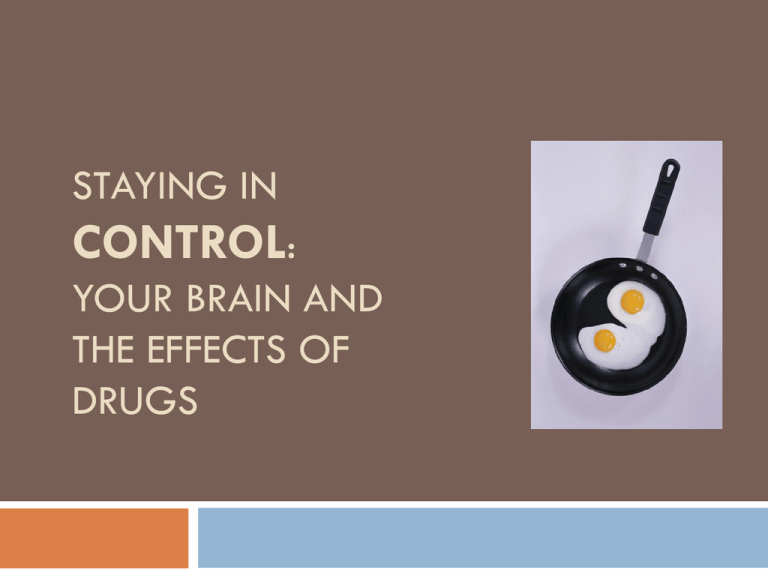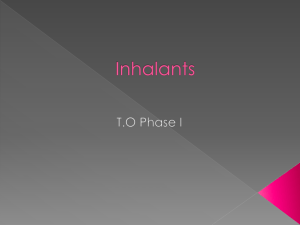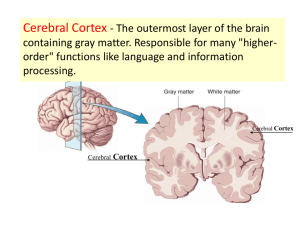CONTROL STAYING IN : YOUR BRAIN AND
advertisement

STAYING IN CONTROL: YOUR BRAIN AND THE EFFECTS OF DRUGS First we’ll talk about the normal brain… …then we’ll talk about the brain on drugs The VIPs of Brain Function The Human Brain The Brain Stem Connects the brain and the spinal cord. Controls many basic functions: Heart rate Breathing Eating sleeping The Human Brain The Cerebellum Coordinates the brain’s instructions for skilled, repetitive movements and for maintaining balance and posture The Human Brain The Limbic System (e.g. amygdala and hippocampus) Control emotions and motivations, particularly those related to survival: Fear Anger Sexual behavior Also involved in feelings of pleasure (example: eating) The Human Brain The Diencephalon contains the thalamus and hypothalamus. Thalamus – involved in sensory perception and regulation of motor functions The Hypothalamus regulates: Feeding hormones Pituitary gland Body temperature Adrenal glands And many other vital activities The Human Brain Nucleus Accumbens Plays a central role in the “reward circuit”. VTA (Ventral Tegmental Area) One of the primitive parts of the brain Involved in the mechanisms of pleasure The Human Brain The Cerebral Cortex Approximately 2/3 of the weight of the brain Most highly developed part of the brain Responsible for Thinking Perceiving Language (both speaking and understanding the spoken word) NOW…THE EFFECTS OF DRUGS Marijuana THC (tetrahydrocannabinol) is the main ingredient in marijuana that causes users to experience a calm euphoria. THC interferes with the normal functioning of The cerebellum (balance, posture, coordinated movement) hippocampus (involved in memory formation) cerebral cortex (receiving sensory messages, i.e., touch, sight, hearing, taste and smell) Opiates Derived from the poppy plant and have been used for centuries to relieve pain. Examples: opium, heroin, morphine, and codeine. Opiates activate the brain’s reward system (VTA, nucleus accumbens, and cerebral cortex), causing an intense euphoria that lasts only briefly, but is followed by a few hours of a calm and relaxed state. Opiates (continued) Excessive amounts of an opiate can cause breathing to slow down and stop altogether. The brain produces endorphins which help to relieve or control pain. Sometimes when pain is severe, the brain does not make enough endorphins to provide pain relief. Opiates have been used by physicians for years without causing additictions. Inhalants Most inhalants are common household products that give off mind-altering chemical fumes when sniffed. It is known that vaporous fumes can change brain chemistry and may be permanently damaging to the brain and central nervous system. Inhalants (continued) Sudden Sniffing Death (SSD) – inhalant replaces the oxygen in the lungs and the central nervous system. The user suffocates. Use of inhalants can cause: Disruption of the normal heart rhythm / cardiac arrest Hepatitis Liver failure Muscle weakness Anemia Sleep problems Drug cravings Severe anxiety Steroids Anabolic Steroids are chemicals that are similar to testosterone. While quite successful in body building, they can damage other organs in the body. Steroids affect the hypothalamus and limbic system. Stimulants Stimulants – Examples: Cocaine Amphetamines Caffeine • Speed up activity in the brain and spinal cord Methamphetamine Tobacco Nicotine – the main ingredient that acts in the brain and produces addiction


